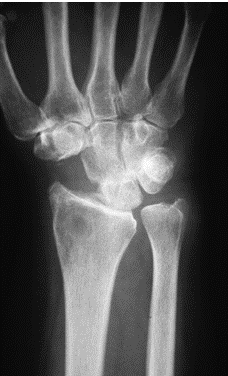Last Updated on July 24, 2019
Four corner arthrodesis involves excision of scaphoid and fusion of the remaining wrist bones in neutral alignment. It is motion preserving limited arthrodesis and provides pain relief and improved grip strength.
This four corner arthrodesis is based on the principle that the radiolunate articulation is often spared from degenerative changes from conditions.
Indications
- SLAC wrist
- Chronic dynamic carpal instability
- Chronic perilunar instability not amenable to soft tissue surgery
Contraindications
- Ulnar Translocation
- Radiolunate arthritis
Procedure
The surgical procedure is typically performed under regional anesthesia.
A standard operating table and radiolucent hand table is used. The patient is kept in supine position.
A standard dorsal longitudinal incision between the third and fourth extensor compartment of the wrist. The incision is centered on proximal carpal row.
The tubercle of Lister is used as a landmark.

Divide the third and fourth compartments by incising the retinaculum and then septae. The tendons are retracted unlarwards
The joint capsule is opened individual carpal joints are exposed. Expose the midcarpal joint and the radial half of the radiocarpal joint.
Split the dorsal dorsal radiocarpal and dorsal intercarpal ligaments taking along the apex of the triquetrum
The flap is elevated radially detaching the dorsal capsule from the radius.
The ulnocarpal joint is exposed by splitting the dorsal radiocarpal ligament longitudinally followed by incising the capsule along the extensor carpi tendon.
This flap is elevated proximally
The scaphoid is excised after identification either piecemeal fashion with a rongeur or sharply using a scalpel. Volar radioscaphocapitate ligament should be carefully protected.
After excision, the wrist is prepared for fusion.
The fusion surfaces between the lunate, capitate, hamate, and triquetrum are then denuded down to the cancellous bone.
Volar third cartilage is removed from lunate and capitate to correct the deformity.
Reduction of the collapse deformity to realign the midcarpal joint is critical to the success of the procedure. The lunotriquetral relationship is reduced and secured with Kirschner wires.

The graft from scaphoid or distal radius is meticulously packed into the fusion sites. The proximal carpal row is reduced and stabilized with either multiple Kirschner wires or cannulated screws.
Specially designed plates are also used for fixation.
For plate fixation, after temporarily securing the fixation, the plate is centered over the four bones and fixed by two screws in each of the four carpal bones.
The first screw is placed through the plate into the lunate and second in the opposite hole. The screws are tightened after checking plate position in the C-arm.
The remaining screws are applied and final image is obtained
After surgery, patients are placed in a compressive dressing with an internal short arm splint. Digital motion is encouraged immediately after the effect of anesthesia wanes off.
At 10 to 14 days postoperatively, a short arm cast is applied in those individuals treated with pins alone. These are typically removed at approximately 8 weeks postoperatively, at which time therapy is begun.
Complications of Four Corner Arthrodesis
Following complications have been reported with four corner arthrodesis.
- The most common complication after four-corner fusion is dorsal radiocarpal impingement in wrist extension. This occurs secondary to an inadequate reduction of the capitolunate relationship
- Reflex sympathetic dystrophy
- Infections
- Nonunion
- De Quervain’s tenosynovitis
Non union is very rare in four corner arthrodesis. There is a reported failure rate of 2%.